Elements
Elements
Kalaripayatt
[
English
]
- Country :
- India
Description :
Kalarippayattu is a traditional holistic Martial Art with strong links to Yoga and Ayurveda. 'Kalari' translates as “place of training”, 'Payattu' as “combat exercises”. Kalaris are also important centers of religious worship.
The initial physical training (Meippayattu) consists of animal postures arranged in flowing forms which, like Yoga, develop far more than flexibility and strength. It operates on a psychophysical level which can aid personal awareness and confidence amongst other attributes. The next level of practice involves wooden and metal weapons which again develop the senses as much as key fighting skills. What is also interesting, and again confirms Kalari's holistic ways, is the stages of training combine fighting with healing at almost all levels. The primary aim is the ultimate coordination between mind and body.
Another focus of Kalaripayattu is specialization in indigenous medicinal practices. Kalaripayattu masters practiced not only the martial craft, but also medicine (kalari chikitsa) and herbalism, which they used to heal the wounds of soldiers who had been hurt in battle.
Kalaripayattu originates in the southwest of India, in today’s state of Kerala and also partly Tamil Nadu. It is often believed to be the oldest martial art in the world, with deep roots in Indian mythology that look back on thousands of years of tradition.
There are 3 acknowledged styles of Kalaripayattu – Northern, Southern, and Central – with the names referring to different parts of the Kerala region. The Northern and the Southern styles each have their own mythical gurus – Parashurama and Agastya Muni, respectively – and their own founding myths. For millennia these arts, their military techniques and associated rituals were shrouded in mystique, with only ancient Indian literature to go by. They started becoming less arcane around the 10th-12th century AD when Keralite society became militarized due to fights between kingdoms and dynasties. Military academies, known as Kalari, were created to instruct young people on how to use weapons and then join local troops.
After a heydey in the 16th and 17th centuries, the importance of Kalaripayattu and the warriors who practiced it gradually declined due to developments in societal structure and military technique. When the British colonized India in the mid-19th century, they considered the warriors a threat to British authority, and the practice of Kalaripayattu was banned on penalty of death or exile.
It wasn’t until the 1920s when a wave of rediscovery of historic traditions swept over India, there was the rise of Kalaripayattu schools, as well as a revival of the spirit of the martial art itself. Kalaripayattu presentations became very popular, as people enthusiastically recalled the heroic past of their country. Nowadays, there are many kalaris in Kerala, with dozens of schools in every town, and quite a few in other parts of India, in big cities such as Mumbai, Delhi, Chennai, or Bangalore. There are also teachers operating in countries all over the world.
The initial physical training (Meippayattu) consists of animal postures arranged in flowing forms which, like Yoga, develop far more than flexibility and strength. It operates on a psychophysical level which can aid personal awareness and confidence amongst other attributes. The next level of practice involves wooden and metal weapons which again develop the senses as much as key fighting skills. What is also interesting, and again confirms Kalari's holistic ways, is the stages of training combine fighting with healing at almost all levels. The primary aim is the ultimate coordination between mind and body.
Another focus of Kalaripayattu is specialization in indigenous medicinal practices. Kalaripayattu masters practiced not only the martial craft, but also medicine (kalari chikitsa) and herbalism, which they used to heal the wounds of soldiers who had been hurt in battle.
Kalaripayattu originates in the southwest of India, in today’s state of Kerala and also partly Tamil Nadu. It is often believed to be the oldest martial art in the world, with deep roots in Indian mythology that look back on thousands of years of tradition.
There are 3 acknowledged styles of Kalaripayattu – Northern, Southern, and Central – with the names referring to different parts of the Kerala region. The Northern and the Southern styles each have their own mythical gurus – Parashurama and Agastya Muni, respectively – and their own founding myths. For millennia these arts, their military techniques and associated rituals were shrouded in mystique, with only ancient Indian literature to go by. They started becoming less arcane around the 10th-12th century AD when Keralite society became militarized due to fights between kingdoms and dynasties. Military academies, known as Kalari, were created to instruct young people on how to use weapons and then join local troops.
After a heydey in the 16th and 17th centuries, the importance of Kalaripayattu and the warriors who practiced it gradually declined due to developments in societal structure and military technique. When the British colonized India in the mid-19th century, they considered the warriors a threat to British authority, and the practice of Kalaripayattu was banned on penalty of death or exile.
It wasn’t until the 1920s when a wave of rediscovery of historic traditions swept over India, there was the rise of Kalaripayattu schools, as well as a revival of the spirit of the martial art itself. Kalaripayattu presentations became very popular, as people enthusiastically recalled the heroic past of their country. Nowadays, there are many kalaris in Kerala, with dozens of schools in every town, and quite a few in other parts of India, in big cities such as Mumbai, Delhi, Chennai, or Bangalore. There are also teachers operating in countries all over the world.
Information source :

